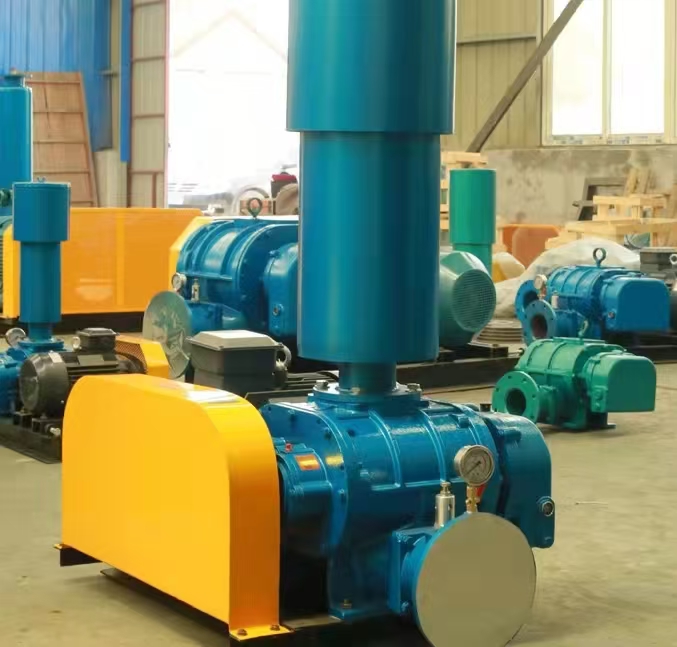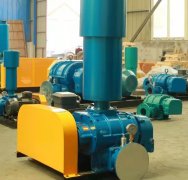Roots blower is a type of volumetric gas delivery equipment, whose core working principle is based on the rotational motion of two interlocked rotors in a closed chamber, forcing the displacement of gas to achieve constant flow delivery. The following is a detailed analysis of its working principle:
---

**1、 Core workflow**
1. * * Inhalation stage**
-When the rotor rotates, a low-pressure zone is formed on the inlet side, and gas is drawn into the enclosed chamber between the rotor and the housing.
-* * Key feature * *: No internal compression, suction gas pressure ≈ atmospheric pressure.
2. * * Transition phase**
-The rotor continues to rotate, pushing the gas inside the enclosed chamber along the shell towards the exhaust port.
-Gap control: Maintain a gap of 0.1-0.3mm (without mechanical contact) between rotors and between rotors and shells.
3. * * Exhaust Stage**
-The gas is pushed to the exhaust port, creating pressure due to system resistance (usually 9.8~98 kPa).
-Pulsation characteristics: Two blade rotors produce significant airflow pulsation, while three blade rotors can reduce pulsation by more than 30.
---
**2、 Core structure function**
|* * Component * * | Function Description | Technical Parameter Example|
|-----------------|-----------------------------------------|-----------------------------|
|* * Rotor * * | Two blade/Three blade spiral shape, forced gas displacement | Gradual opening line, hardness C55-60|
|* * Synchronous gear * * | Ensure non-contact reverse rotation of the two rotors (constant clearance) | Accuracy level AGMA 8|
|* * Shell * * | Forming a closed working chamber to withstand pressure loads | Cast iron HT250/stainless steel 304|
|* * Bearing * * | Supports the rotor and withstands radial/axial forces | Combination of deep groove ball bearings and cylindrical roller bearings|
---
**3、 Mathematical Modeling and Key Formulas**
1. Theoretical flow calculation**
$$
Q = \lambda \cdot n \cdot V
$$
-(Q): Actual flow rate (m3/min)
-\ (\ lambda \): Volumetric efficiency (0.75~0.9)
-(n): Speed (rpm)
-(V): Rotor displacement per revolution (m3/r)
*Example *: A certain model \ (V=0.012 \, \ text {m}3 /\text{r} \), \( n=1450 \, \text{rpm} \), \( \lambda=0.85 \) → \( Q≈14.8 \, \text {m}3 /\text{min} \)
2. Principle of Pressure Establishment**
-The pressure is determined by the system resistance, and the fan itself does not generate internal compression
$$
P_{\text{out}} = P_{\text{in}} + \Delta P_{\text{system}}
$$
-Pressure limited by rotor clearance leakage (efficiency drops sharply when>98kPa)
---
**4、 Dynamic characteristic analysis**
|* * Parameters * * | Characteristics of Roots blower | Comparison with centrifugal blower|
|------------------|-----------------------------------------|-----------------------------|
|Flow pressure curve | Constant flow rate, almost unaffected by pressure | Flow rate decreases with increasing pressure|
|* * Efficiency Curve * * | Efficiency 60-75, wider range | narrower range (only ± 10 design points)|
|* * Transient response * * | Flow rate without hysteresis during sudden pressure changes | Valve/speed needs to be adjusted to adapt to pressure changes|
---
**5、 Typical application scenarios**
1. * * Sewage treatment aeration**
-Stable flow rate is required (e.g. SBR process requires 6-10 m3/min per unit)
-Pressure range: 49~78.4 kPa (overcoming resistance at depths of 4~6m)
2. * * Pneumatic conveying system**
-Powder conveying wind speed: 15~25 m/s
-Key design: A cyclone separator needs to be installed in front of the fan to prevent particles from entering
3. * * Vacuum packaging assistance**
-Working vacuum degree:- 20~-50 kPa
-Supporting equipment: To be used in series with a vacuum pump
---
**6、 Operation restrictions and protection**
1. * * Operation strictly prohibited**
-Overpressure operation (valve required, set pressure=1.1 x rated pressure)
-Long term idling (no gas cooling can cause overheating)
2. * * Temperature control**
-Bearing temperature ≤ 85 ℃ (PT100 monitoring)
-Gear oil temperature ≤ 70 ℃ (air-cooled/water-cooled optional)
---
**7、 Key points of selection design**
1. * * Selection of rotor profile**
|* * Type * * | Advantages | Disadvantages | Applicable Scenarios|
|----------|-----------------------|-----------------------|-----------------------|
|Two leaves | Simple structure, low cost | Large pulsation (± 10 flow fluctuations) | Low pressure extensive working conditions|
|San Ye | Low noise, smooth airflow | High processing accuracy requirements | High precision gas supply/silence requirements|
2. * * Gap adjustment standard**
-Between rotors: 0.10~0.15mm
-Rotor and shell: 0.15~0.25mm
-Adjustment tool: feeler gauge+dial gauge (requires cold calibration)
---
**8、 Maintain key steps**
1. * * Daily inspection**
-Gear oil level (replenish ISO VG220 lubricating oil every 500 hours)
-Vibration value monitoring (≤ 4.5 mm/s, GB/T 1236 standard)
2. * * Overhaul content**
-Replace the rotor every 20000 hours (when the wear is greater than 0.5mm)
-Synchronous gear backlash adjustment (standard 0.05~0.08mm)
---
**Summary * *:
Roots blower achieves flow stability through forced conveying by volume, suitable for medium and low pressure, constant flow scenarios. When selecting, it is necessary to focus on checking:
-* * Flow matching * *: According to process requirements x 1.1 margin
-Pressure limit: Long term operation ≤ 90 rated pressure
-* * Special medium * *: Corrosive gases require 316L stainless steel rotors
Attachment: [Dynamic Demonstration of Working Principle]( https://example.com/roots-animation )(including visualization of airflow path and pressure changes)



